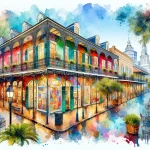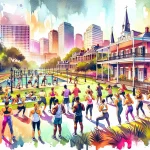Tucked within the lush greenery of New Orleans’ City Park, the Sydney and Walda Besthoff Sculpture Garden stands as a harmonious blend of art and nature. Spanning 12 acres, this open-air museum showcases an impressive collection of over 90 sculptures from renowned local and international artists, making it an enticing destination for art aficionados and nature enthusiasts alike.
In This Article
TL;DR
- The garden features a diverse range of sculptures from local and international artists, offering a unique fusion of art and nature.
- It serves as a cultural hub, providing educational programs, guided tours, and special events to engage the community and visitors.
- The thoughtful design and layout enhance the visitor experience, making it a must-visit attraction for art and nature lovers.
The Essence of the Garden
The City Park Sculpture Garden’s origins can be traced back to 2003 when Sydney and Walda Besthoff, prominent art collectors and philanthropists, generously donated their extensive sculpture collection to the New Orleans Museum of Art (NOMA). This gift laid the foundation for what would become one of the most significant sculpture gardens in the United States.
The garden has since become an integral part of New Orleans’ cultural landscape, serving as a gathering place for locals and an captivating attraction for visitors. Its seamless integration of art and nature creates a serene and thought-provoking environment that encourages contemplation, inspiration, and a deeper appreciation for the beauty that surrounds us.
Sculptures and Artists
The City Park Sculpture Garden boasts an eclectic mix of sculptures, ranging from classic to contemporary, and representing a wide array of artistic styles and mediums. Visitors can admire works by internationally acclaimed artists such as Auguste Rodin, Henry Moore, and Louise Bourgeois, alongside pieces by local Louisiana artists.
One of the garden’s most striking installations is the towering “Pablo Casals’s Obelisk” by French-born artist Arman. Standing over 20 feet tall, this imposing bronze sculpture is a tribute to the renowned Spanish-Puerto Rican cellist and human rights activist Pablo Casals. Other notable works include Yinka Shonibare’s “Wind Sculpture,” a colorful and dynamic piece that seems to dance with the breeze, and Elyn Zimmerman’s “Mississippi Meanders,” a mesmerizing bridge that illuminates the lagoon at dusk.
Design and Layout
The garden’s design is a testament to the power of landscape architecture in enhancing the aesthetic and emotional impact of the artworks. Winding footpaths lead visitors through a picturesque landscape of mature live oaks, pines, magnolias, and serene lagoons, creating intimate viewing spaces that allow for a more personal connection with the sculptures.
The thoughtful placement of each piece ensures that the sculptures complement and draw inspiration from their natural surroundings. The interplay of light and shadow, the rustling of leaves, and the gentle ripples on the water’s surface all contribute to a multi-sensory experience that elevates the appreciation of both art and nature.
Educational Programs and Events
The City Park Sculpture Garden is more than just a display of art; it is a vibrant cultural hub that actively engages with the community through a variety of educational programs and events. NOMA offers guided tours, workshops, and lectures that cater to different age groups and interests, providing opportunities for visitors to deepen their understanding and appreciation of the artworks.
The garden also hosts special events throughout the year, such as the annual “Art in Bloom” festival, which celebrates the intersection of floral design and fine art. During this event, local florists and designers create stunning arrangements inspired by the sculptures, transforming the garden into a colorful and fragrant wonderland.
Visitor Experience
To make the most of your visit to the City Park Sculpture Garden, plan to spend at least an hour exploring the grounds. The garden is open seven days a week, with extended hours during the summer months (April to September, 10 am to 6 pm) and slightly shorter hours during the winter (October to March, 10 am to 5 pm).
Admission to the sculpture garden is free, making it an accessible and affordable cultural experience for all. The garden is fully wheelchair accessible, with barrier-free pathways and benches throughout the property for those who need to rest or simply wish to sit and admire the artworks.
Be sure to pick up a complimentary map at the entrance or download the NOMA mobile guide to enhance your visit with audio tours and additional information about the sculptures and artists.
Community Engagement and Impact
The City Park Sculpture Garden is deeply rooted in the New Orleans community, fostering partnerships with local schools, artists, and cultural organizations. NOMA collaborates with educators to develop curriculum-based programs that introduce students to the world of sculpture and encourage creative expression.
The garden also serves as a platform for emerging and established local artists, providing opportunities for them to showcase their work alongside internationally renowned sculptors. This commitment to supporting and promoting local talent contributes to the vibrant arts scene in New Orleans and helps to nurture the next generation of artists.
Beyond its cultural impact, the sculpture garden is a significant driver of tourism and economic development in the city. As a free and accessible attraction, it draws visitors from around the world, contributing to the local economy and helping to support the park’s ongoing maintenance and expansion efforts.
Conservation and Sustainability
Preserving the sculptures for future generations is a top priority for the City Park Sculpture Garden. The garden’s dedicated conservation team works tirelessly to maintain and restore the artworks, employing state-of-the-art techniques to protect them from the elements and ensure their longevity.
In addition to its conservation efforts, the garden is committed to sustainable practices in its operations and maintenance. The use of native plants, efficient irrigation systems, and eco-friendly pest control methods helps to minimize the garden’s environmental impact and promote the health of the surrounding ecosystem.
Comparisons and Context
While sculpture gardens can be found in cities across the United States and around the world, the City Park Sculpture Garden stands out for its unique setting and its deep connection to the cultural heritage of New Orleans. The garden’s location within the historic City Park, surrounded by centuries-old live oaks and serene lagoons, creates an immersive experience that is distinctly Louisiana.
The sculpture collection itself reflects the diverse influences that have shaped New Orleans’ artistic landscape, from the classical European tradition to the vibrant African and Caribbean cultures that have long enriched the city’s creative spirit. This fusion of styles and perspectives makes the City Park Sculpture Garden a truly one-of-a-kind destination.
Deep Expertise
Art historians, landscape architects, and cultural experts agree that the City Park Sculpture Garden is a remarkable example of how public art can transform urban green spaces and enrich the lives of those who experience it. The garden’s thoughtful design, which seamlessly integrates art and nature, reflects a growing trend in urban planning that recognizes the importance of creating accessible, multi-functional public spaces that promote well-being and cultural engagement.
As Dr. Miranda Lash, curator of contemporary art at NOMA, notes in the book “The Sydney and Walda Besthoff Sculpture Garden at the New Orleans Museum of Art,” the garden “offers a unique opportunity to experience art in a natural setting, inviting visitors to slow down, to look closely, and to engage with the sculptures in a more intimate and personal way”.
This sentiment is echoed by landscape architect Robin Tanner, who worked on the garden’s expansion project. “The sculpture garden is a testament to the power of art and nature to inspire, to heal, and to bring people together,” Tanner observes. “It’s a space that encourages us to step outside of our daily routines and to connect with something greater than ourselves”.
The City Park Sculpture Garden is more than just a collection of artworks; it is a reflection of New Orleans’ enduring spirit, a celebration of the city’s rich cultural heritage, and a promise of a brighter, more beautiful future. As you wander through the garden’s winding paths, surrounded by the timeless beauty of art and nature, you cannot help but feel a sense of connection, inspiration, and joy.
Address: One Collins C. Diboll Circle, City Park, New Orleans, Louisiana 70124
Phone: 504.658.4100
Website: https://noma.org/besthoff-sculpture-garden/
Hours of Operation:
Open seven days a week
Summer Hours (April–September): 10 am–6 pm
Winter Hours (October–March): 10 am–5 pm
Admission:
Free; donations appreciated.






